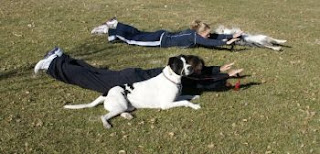All movements should be slow and measured, use a 3 count. Count to 3 on the “down” movement, and 3 on the “up” movement. While you are performing the exercises have your dog practicing their “sit,” “downs” or “watch me’s.” Between each exercise walk at a varying speed for 4 minutes. Try to increase the speed at which you are walking, and increase the number of faster-paced walks. Hold your leash in your right hand, and treat with your left. The goal is to treat when your dog is walking beside you on a loose leash. Make use of obstacles such as benches, tables or trees to walk around, the variety of pace and direction will help keep your dog focused on you. When you make a right circle speed up your pace a little so your dog will learn to speed their pace to stay beside you, and with left circle slow your pace.
Be sure to have water for both you and your dog. Take water breaks every 10-15 minutes. I find it easiest to set the dog’s water dish near a bench. I can then place my water bottle close, and we can both take a water break. You may want to print this article and place it near the water so you can refresh your memory of the exercises.
This routine should take you approximately 45 minutes to complete.
Start with a 5 minute warm-up, walk at your normal pace for several minutes, then at a faster pace. Your dog should be on a loose leash, walking beside you.
Lunges with a step up - Find a step or stairs and place one foot on it. Slowly lower your body until your thigh is approximately at a 90 degree angle. Don't let your knee extend over you toe. The higher the step up the greater the workout. For a much more difficult workout lunge forward as shown in the picture, then place your back foot on the step and lunge forward. Between each lunge walk for 4 minutes. Your dog should be sitting close to you.
Push ups with a leg lift– Have your dog “sit” beside you, or underneath you. Gently lower your chest to the object using the 3 count, then raise yourself using the 3 count. While you are in the “up” position raise one leg as high as you comfortably can. Complete your 4-minute walk and complete another set raising the other leg.
Roman Twists Sit and the ground and raise your legs and find your point of balance. You can hold the leash and twist from side to side as shown, or simply twist from side to side. Your dog should be laying beside you. Do as many as you can.
Walk for 3-5 minutes as a cool down and you’re done!! But feel free to challenge yourself and repeat the workout. Try to perform the workout at least 3 times during the week.
Mary Manka, owner
Push Ups n PawS, LLC




.JPG)
.JPG)
.JPG)


.JPG)


.JPG)




.JPG)
.JPG)
.JPG)




.JPG)

.JPG)
.JPG)

.JPG)
.JPG)
.JPG)

.JPG)




.JPG)







.jpg)